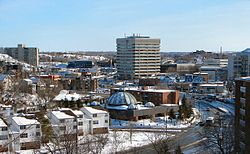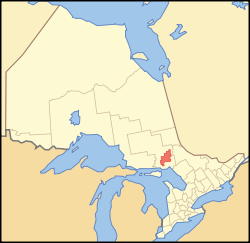
Back غريتر سودبوري Arabic جريتر سودبورى ARZ بۆیوک سادبری AZB Грэйтэр-Садберы Byelorussian Садбэры BE-X-OLD Sudbury (Ontario) Catalan Greater Sudbury CEB Greater Sudbury Czech Greater Sudbury Danish Greater Sudbury German
Greater Sudbury | |
|---|---|
| City of Greater Sudbury Ville du Grand Sudbury (French) | |
 Downtown Sudbury | |
|
| |
| Nicknames: | |
| Motto(s): | |
 | |
| Coordinates: 46°34′40″N 81°04′10″W / 46.57778°N 81.06944°W[3] | |
| Country | Canada |
| Province | Ontario |
| Founded | 1883 |
| Incorporated (Town) | 1893 (as Sudbury) |
| Re-Incorporated (City) | 1930 (as Sudbury) |
| 2001 (as Greater Sudbury) | |
| Government | |
| • Mayor | Paul Lefebvre |
| • Governing Body | Greater Sudbury City Council |
| • MPs | Viviane Lapointe (Liberal) Marc Serré (Liberal) |
| • MPPs | France Gélinas (NDP) Jamie West (NDP) |
| Area | |
| • City (single-tier) | 3,228.35 km2 (1,246.47 sq mi) |
| • Urban | 75.93 km2 (29.32 sq mi) |
| • Metro | 3,924.48 km2 (1,515.25 sq mi) |
| Elevation | 347.5 m (1,140.1 ft) |
| Population (2021)[4] | |
| • City (single-tier) | 166,004 (29th) |
| • Density | 49.7/km2 (129/sq mi) |
| • Urban | 92,093[5] |
| • Urban density | 1,159.7/km2 (3,004/sq mi) |
| • Metro | 170,605 (24th) |
| • Metro density | 49.5/km2 (128/sq mi) |
| Time zone | UTC−05:00 (EST) |
| • Summer (DST) | UTC−04:00 (EDT) |
| Forward sortation area | |
| Area code(s) | 705/249 |
| Telephone exchanges | 705–207, 222, 280, 396, 397, 479, 507, 521, 522, 523, 524, 525, 546, 547, 550, 551, 552, 553, 554, 556, 560, 561, 562, 564, 566, 585, 596, 618, 626, 662, 664, 665, 669, 670, 671, 673, 674, 675, 677, 682, 688, 690, 691, 692, 693, 694, 695, 698, 699, 805, 822, 853, 855, 858, 866, 867, 897, 898, 899, 919, 920, 929, 966, 967, 969, 983 249-810, 878 |
| Highways | |
| GDP (Greater Sudbury CMA) | CA$9.7 billion (2020)[6] |
| GDP per capita (Greater Sudbury CMA) | CA$54,491 (2016) |
| Website | www.greatersudbury.ca |
Sudbury, officially the City of Greater Sudbury, is the largest city in Northern Ontario by population, with a population of 166,004 at the 2021 Canadian Census.[4] By land area, it is the largest in Ontario and the fifth largest in Canada. It is administratively a single-tier municipality and thus is not part of any district, county, or regional municipality. The City of Greater Sudbury is separate from, but entirely surrounded by the Sudbury District. The city is also referred to as "Ville du Grand Sudbury"[7] among Francophones.
The Sudbury region was inhabited by the Ojibwe people of the Algonquin group for thousands of years prior to the founding of Sudbury after the discovery of nickel and copper ore in 1883 during the construction of the Canadian Pacific Railway.[8] Greater Sudbury was formed in 2001 by merging the cities and towns of the former Regional Municipality of Sudbury with several previously unincorporated townships. Being located inland, the local climate is extremely seasonal, with average January lows of around −18 °C (0 °F) and average July highs of 25 °C (77 °F).[9]
The population resides in an urban core and many smaller communities scattered around 330 lakes and among hills of rock blackened by historical smelting activity. Sudbury was once a major lumber center and a world leader in nickel mining. Mining and related industries dominated the economy for much of the 20th century. The two major mining companies which shaped the history of Sudbury were Inco, now Vale Limited, which employed more than 25% of the population by the 1970s, and Falconbridge, now Glencore. Sudbury has since expanded from its resource-based economy to emerge as the major retail, economic, health, and educational center for Northeastern Ontario. Sudbury is also home to a large Franco-Ontarian population, which influences its arts and culture.
- ^ Harold Carmichael (November 18, 2013). "Ukrainians say goodbye to Nickel City". Sudbury Star. Canoe Sun Media. Retrieved January 4, 2014.
- ^ Sudbury Northern Life Staff (March 16, 2010). "Restoring the City of Lakes' aquatic luster". Northern Life. Retrieved December 17, 2012.
- ^ "Greater Sudbury". Geographical Names Data Base. Natural Resources Canada.
- ^ a b c "Census Profile, 2021 Census of Population Data table: City of Greater Sudbury". Statistics Canada. February 9, 2022. Retrieved February 10, 2022.
- ^ "Census Profile, 2021 Census Sudbury [Population centre], Ontario and Ontario [Province]". Statistics Canada. February 9, 2022. Retrieved February 10, 2022.
- ^ "Gross domestic product (GDP) at basic prices, by census metropolitan area (CMA)". December 6, 2023.
- ^ "Contact the City". www.greatersudbury.ca. Retrieved July 14, 2022.
- ^ "History - Greater Sudbury". Greatersudbury.ca. January 1, 2001. Retrieved July 26, 2017.
- ^ Cite error: The named reference
EnvironmentCanadawas invoked but never defined (see the help page).


